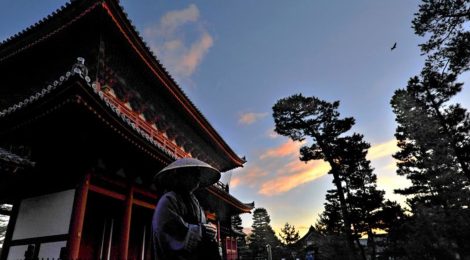
Myoshinji Temple
Zen Solitude, Lodging, and Meditation in the Center of Kyoto
Myoshinji Temple, located in Kyoto, japan, is a place of tranquility and spiritual reflection. With its 46 sub-temples spread across a vast area interconnected by stone paths, the temple offers visitors a unique experience of Zen solitude, lodging, and meditation.
Originally, Myoshinji Temple was the site of an imperial villa until the emperor had it converted into a Zen temple in 1337. Since then, it has been a place of worship and contemplation for monks and visitors alike. The temple is known in Japanese as the “Temple of the Enlightened Mind,” reflecting its dedication to the pursuit of spiritual enlightenment.
To reach Myoshinji Temple, there are two main gates to consider. For the north gate, visitors can take the Keifuku Dentetsu Kitano Line from Katabiranotsuji or Hakubaicho stations to Myoshinji Station. On the other hand, for the south gate, the local train on the JR Sagano Line will take visitors to Hanazono Station, and from there, it is just a five-minute walk to the northeast.
One of the highlights of Myoshinji Temple is the opportunity for temple lodging and morning meditation sessions. This allows visitors to immerse themselves in the Zen experience and gain a deeper understanding of the practices and teachings of Buddhism. The temple offers comfortable accommodations for guests, providing a serene environment for rest and reflection.
Among the 46 sub-temples, three of them, Taizoin, Keishunin, and Daishinin, are open all year round. These sub-temples offer visitors a glimpse into the rich history and cultural significance of Myoshinji Temple. Each sub-temple has its own unique features and attractions, providing a diverse range of experiences for visitors.
One of the notable aspects of Myoshinji Temple is its collection of Important Cultural Properties. Most of the original buildings were destroyed during the Onin War from 1467 to 1477. However, the buildings that stand today date back to the late 15th to 17th centuries. The Sanmon gate and Butsuden Hall are designated as Important Cultural Properties and are off-limits to visitors. The Hatto Hall, another significant building, features a stunning ceiling painting of a dragon that captivates visitors with its gaze, no matter where they stand in the hall.
One of the sub-temples, Taizoin, stands out for its Japanese rock garden. Built in the 1400s, Taizoin’s rock garden is a dynamic combination of garden stones that create a picturesque landscape resembling a painting. Visitors can admire the dry waterfall, an island shaped like a turtle, and a stone bridge that complete the harmonious composition of the rock garden. Adjacent to Taizoin’s rock garden is a pond garden created in the 1960s. This garden is considered one of Japan’s most beautiful gardens from the Showa era, showcasing the meticulous craftsmanship and appreciation for nature.
Another sub-temple, Keishunin, founded in 1558, boasts two different types of gardens with distinct sizes and characters. Visitors can enjoy the view of these gardens from the teahouse attached to the temple. The teahouse provides a serene setting to savor a cup of Japanese tea while immersing oneself in the beauty of the surrounding gardens.
Daishinin, the smallest of the four sub-temples, is known for its Peony Garden. This charming garden features a flowerbed at the center, adorned with peonies and surrounded by cut stones. The Peony Garden is a delightful sight, especially during the blooming season when the vibrant colors and fragrant aroma fill the air.
Visiting Myoshinji Temple offers a unique opportunity to experience the tranquility and beauty of Zen Buddhism in the heart of Kyoto. The temple’s serene atmosphere, combined with the rich history and cultural significance, provides a truly immersive experience for visitors seeking solace and spiritual enlightenment.
It is important to note that the information provided may be subject to change due to COVID-19. Therefore, it is advisable to check for any updates or restrictions before planning a visit to Myoshinji Temple.
In conclusion, Myoshinji Temple in Kyoto is a place of profound serenity and spiritual contemplation. Its 46 sub-temples, interconnected by stone paths, offer visitors a unique experience of Zen solitude, lodging, and meditation. With its rich history, Important Cultural Properties, and stunning gardens, Myoshinji Temple is a must-visit destination for those seeking a deeper understanding of Zen Buddhism and a peaceful retreat in the center of Kyoto.
Address And Maps Location:
64 Hanazonomyoshinji-cho, Ukyo-ku, Kyoto-shi, Kyoto-fu
Subscribe, follow @idbcpr and idbackpacker.com